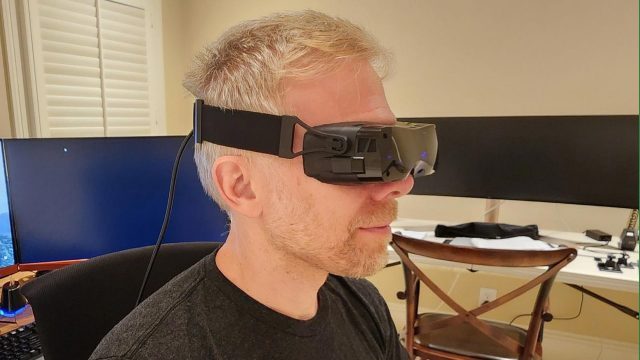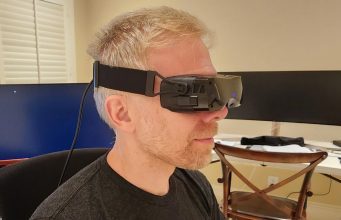

John Carmack, legendary programmer and former CTO of Oculus, is known for giving his unfiltered thoughts on almost every aspect of the XR industry. While he departed Meta in December, concluding his “decade in VR,” Carmack is still very interested in the medium, as he recently went hands-on with one of the latest PC VR headsets to hit the scene, the slim and light Bigscreen Beyond.
Bigscreen Beyond is a tethered PC VR headset that uses Valve’s SteamVR tracking standard, which starting at $1,000 for just the headset makes it an interesting value proposition for users already hooked into the SteamVR hardware ecosystem. It’s largely praised for its slim and light profile, which is thanks to the inclusion of pancake lenses and micro-OLEDs, serving up 2,560 × 2,560 pixels per eye at 70 to 90 Hz refresh.
You’ve probably already heard what we think of it though. Now for the master:
“Bigscreen Beyond feels like a prop for a futuristic movie, but it works!” Carmack said in a Twitter thread on Monday. “Far and away the smallest and lightest PC VR headset.”
That’s high praise coming from a key figure in the Oculus genesis story, not to mention co-founder and lead programmer of id Software, the studio behind pioneering ’90s 3D games Wolfenstein 3D, Doom, and Quake.
To hear all of Carmack’s thoughts on Bigscreen Beyond, we’ve formatted his tweets below for easier reading:
Bigscreen Beyond feels like a prop for a futuristic movie, but it works! Far and away the smallest and lightest PC VR headset.
As a result of the iPhone based face scanning before ordering, the fit is perfect, with zero light leaks. The custom printed facial interface is comfortable, but not breathable, so it isn’t great for fitness activities.
The prescription lens inserts snap in with magnets and work well. The visuals are a trade off vs Quest Pro. The resolution is clearly higher, but there are more internal reflections in the pancake optics, and the quality falls off more toward the edges. There are parts of the view where screens look fantastic, good enough for actual productivity work, but not across the entire view.
I sorely miss integrated audio. Having to mess with headphones severely impacts the minimalist feel of the headset. I know some people have strong opinions, but I still feel Quest made the right decisions around audio.
The cable to the PC and the tracking base stations are the biggest downside. The magic of stand-alone VR is real, and while some people happily trade it away for the raw power and flexibility of a PC, I wouldn’t recommend any PC VR setup as an entry point to VR.
For people considering an upgrade to a PC VR system, Bigscreen Beyond should be in the mix. I am very happy to see this extreme focus on light weight, and I hope it impacts Meta’s future designs.
In a follow-up tweet, Carmack points to a review from Adam Savage’s Tested, which he says “hits most of my points in more depth.”
In it, Tested’s Norman Chan reports back after having lived with the headset for a month, using a development unit as the office’s primary PC VR headset. Chan shows through-the-lens images, and discusses “the good, the bad, and the weird with this unique approach to high-end bespoke VR,” the video’s description reads.
Check out Tested’s review below:
This content was originally published here.









